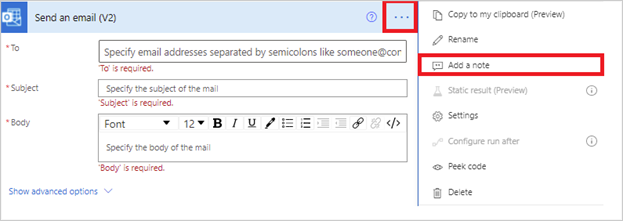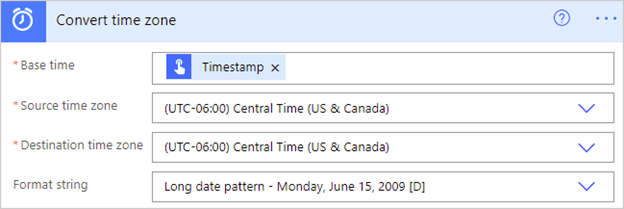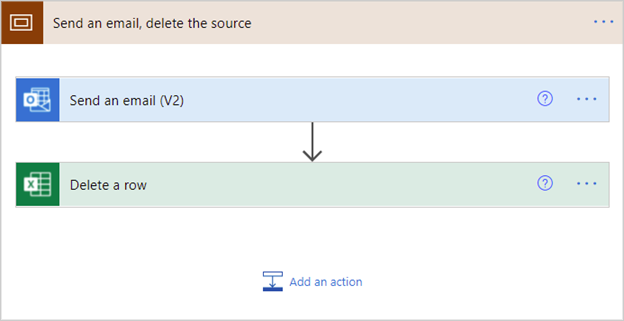Power Automate is a tool that I love. You may or may not know this based on how often I write about it. Automation can be an incredibly powerful tool that will allow you to save time in your everyday life, cutting into the time you spend doing repetitive tasks, and freeing you up to do the cool things that you like to do. Today, we are going to touch on 5 tips and tricks to help you get the most out of your Flows.
Renaming Your Actions
Renaming your actions is a super easy piece that will make it much easier to identify what each action is doing. For example, let’s say you have an action that needs to send an email, instead of leaving it as Send an email (v2), you can rename it to Send a confirmation email. This will help you keep your documentation in line, and will show up in your dynamic flow later on. This can be important if you are using several similar actions, to make sure that you are referring to the correct action.
To rename your actions, simply click on the "…" in the top right corner of your action, and select "Rename".

Commenting On Your Actions
Commenting on your actions is another one of those clean-up tasks that makes it easier for you, and more so people that may be working on the Flow after you, to understand what each piece is doing. You can add more information than when you just rename your action.
To comment on your actions, again start at the "…" in the top right, and select "Add a note". It will appear in a new section, and you can write your comment, and hit enter.

Download a Run History
Sometimes, you need to refer to your run history to make sure everything is running well, or to help you figure out where your issues may be. Downloading a Run History will create an excel file that will provide you with a ton of documentation that could allow either you or the person that created the Flow to be able to troubleshoot.
To download your .CSV file, click on the flow you are questioning, then select "All runs".

Once you are on your runs screen, click on the "Get .csv file" at the top. It will take a few minutes to generate one, and then click on "Download" and you will now have a downloaded copy of every run, with quite a bit of information as to what is being inputted and outputted. The downloaded file contains a lot of information that can be very hard to decipher, but if you are running into a problem and need to get someone more technical involved, it might be a helpful file to supply them with.

Formatting Date and Times
Formatting dates and times can be a little bit of a hassle in Microsoft Power Automate, but don’t be alarmed. There are a few ways we can get around this. We can use an expression:
- Formatdatetime(‘2021-09-01T15:30:00’, ‘D’)
This would return Wednesday, September 1, 2021, as your output. The letter at the end would represent the format specifiers, which can all be found in Microsoft Documentation. Some of the more common expressions not covered in the documentation that you may use would be:
- UtcNow (‘MM’) – Returns the current month in numerical format.
- UtcNow (‘dddd’) – Will give you the text of the day of the week. Great to use if you want to not have something happen over the weekend!
- UtcNow (‘yyyy’) – Returns the year.
These common use cases wouldn’t be to format in a specific way to return info, they would be used to extract specific values from the date, and then you can manipulate them in later conditions, formulas, etc…
Your other option would be to use a Convert Time Zone action if you want to avoid using expressions. All you would need to do is set the base date and time (which would probably be dynamic content), then set the source, and destination time zones the same, and finally, pick how you would like to have it formatted in the Format String box.

Using Scopes to Organize Complex Flows
The last one we are going to talk about is using scopes. We have had our developer Jon go over how to keep your flows organized using scopes, so for more detail, go check that out. Scopes are actions in Power Automate that do not perform work, but they can contain other actions. This will allow you to take long complex flows and put parts into scopes. This will keep everything organized and simplistic on your screen.
To use a scope, select it from your actions, and then take the parts that you want to be in your scope, and drag and drop them in. It is that easy to keep yourself organized. Make sure that you are also naming your scope, so you know what is going on in it.

Best Practices to Get You Started
There are 5 tips and tricks that may have caught you up using Power Automate. I have seen all of these pop up a few times while creating flows, and now you will only have to refer to one page to get your answers.
A reminder that the Microsoft documentation is also an amazing place to look to see if you can find a solution to your issues. If you cannot, reach out to us, and we will be happy to help you out.



